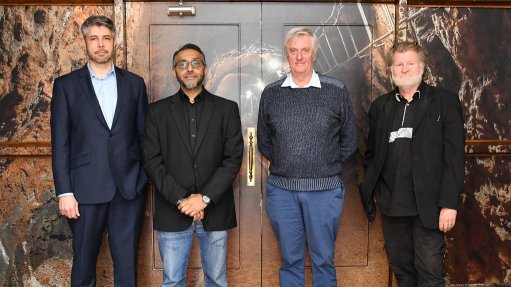
RIIS executive Clen Cook, MMP co-directors Navin Singh and Alastair Macfarlane and Mining Equipment Manufacturing of South Africa CEO Paul Jourdan
Photo by: Dylan Slater
The Mandela Mining Precinct (MMP) on Monday launched an open-innovation challenge to rapidly develop a new deep-level mining rock drill by the beginning of next year.
MMP co-director Alastair Macfarlane explains that, for South Africa to retain its comparative advantage obtained through the mining of its typically deep and narrow-orebody, tabular reserves, it must develop new rock drills.
Current rock drills are typically pneumatic drills that weigh about 30 kg, are noisy, energy-inefficient and difficult to set up, dismantle and operate.
The first phase of the challenge to develop a new rock drill concept, launched in partnership with the Research Institute for Innovation and Sustainability (RIIS), will run for 30 days from August 20 to September 18 and is open to any participant, says RIIS executive Clen Cook.
The new designs must meet four key criteria, namely that the rock drill must weigh less than 16 kg, must use an energy source other than compressed air, must enable parallel drilling of holes and must take less than 10 to 15 minutes to set up and dismantle.
The secondary criteria are that the new concept drills must produce more thrust than current drills, must produce less than 85 dB of noise, must reduce vibrations experienced by the operator, must improve on drilling speed or penetration, must be easily operable by the rock drill operator and must be human-centred.
Those interested in participating in the challenge must submit computer-aided design models or technical sketches, with accompanying technical notes, to support@isidingodrill.co.za by September 18, says Cook.
“The challenge has been designed to be as open as possible, with as few constraints as possible to invite as wide a range of ideas as possible. The second phase of the challenge, to run for 60 days from October 15 to December 14, will get participants to develop a proof of concept and, the final phase, from the end of January 2019, will get them to develop a prototype.”
RIIS and MMP, as well as a host of technical mining, industrial and academic partners will assess each of the concepts based on the design criteria. The suitability of the concepts according to health and safety regulations will also be considered, but only during subsequent phases.
“Innovation is often constrained by our contexts, technical disciplines and knowledge. Therefore, opening the challenge to any participant, whether from within the mining industry, manufacturers, supply chain partners, academics, students, industrial or mechanical engineers, graphic designers, architects or even school children, will garner a range of ideas that we can use.”
Additionally, the goal is not mechanisation or automation, but does not exclude these concepts.
The stope, where rock drilling takes place, is the most dangerous area of a mine and removing operators from this immediate area will reduce injuries and death. The vision is to have the operator outside the immediate drilling area, but still within sight of the drill, explains Macfarlane.
MMP co-director Navin Singh added that improving the performance of the drill, including drilling speed or penetration, will reduce the exposure of operators to dangerous conditions and immediately help to reduce injury and death.
The challenge design criteria were drawn up after consultations with rock drill operators, as the key people that will be impacted by the development of new drills, explains Cook.
“Lighter drills will cause less fatigue and enable a wider range of operators to use them. Faster drilling and less time required to set up will improve productivity of the drill operators. More accurate drilling and parallel holes will enable better blasting, reduce risk from rock fractures caused by blasting and improve the consistency of drill and blast mining.”
The design challenge for a new rock drill is, meanwhile, also focused on stimulating local innovation, development and the manufacture of new drills.